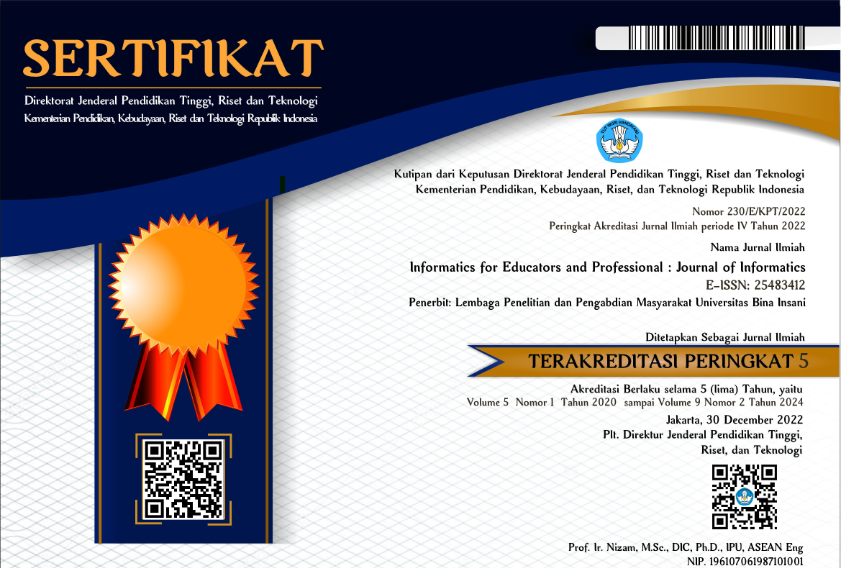Pemantauan Kualitas Udara Terintegrasi dengan Semantic Web Of Thing
Abstract
Abstrak: Udara merupakan salah satu sumber daya alam yang paling penting bagi keberadaan makhluk hidup di bumi ini. Semua organisme hidup membutuhkan kualitas udara yang baik bebas dari gas berbahaya untuk melanjutkan hidup mereka. Beberapa organisasi telah membuat sistem monitoring dengan struktur data yang berbeda tanpa adanya standar penyamaan. Di sisi lain, manusia masih membutuhkan waktu untuk menafsirkan data-data sensor untuk mendapatkan informasi. Linked Data merupakan metode untuk merepresentasikan dan menghubungkan data terstruktur pada web. Data terstruktur tersebut diintegrasikan dengan Semantic Sensor Web (SSW) yang dipublikasikan pada beberapa format sehingga mudah dibaca mesin dan dapat dihubungkan ke data terstruktur lainnya. Kemudian, untuk menyajikan data yang aktual, sistem monitoring didesain untuk menerima data secara terus-menerus, diquery secara real-time dan dibagikan melalui sosial media.Kata kunci: Linked Data, Pemantauan Kualitas Udara, Semantic Web, Sosial Media.
Abstract: Air is one of the most essential natural resources for the existence and survival of the entire life on this planet. all living organisms need good quality of air which is free of harmful gases to continue their life. Some organizations have set up monitoring systems with different data structures without an equalization standard. On the other hand, humans still need time to interpret sensor data to get information. Linked Data is a method for representing and connecting structured data on the web. The structured data is integrated with the Semantic Sensor Web (SSW) which is published in several formats so that it is easy to read and can be connected to other structured data. Then, to present the actual data, the monitoring system is designed to receive data continuously, queried in real time and shared through social media
Keywords: Air Quality Monitoring, Linked Data, Semantic Web, Social Media
References
[1] G. K. Kang, J. Z. Gao, S. Chiao, S. Lu, and G. Xie, “Air Quality Prediction: Big Data and Machine Learning Approaches,†Int. J. Environ. Sci. Dev., vol. 9, no. 1, pp. 8–16, 2018, doi: 10.18178/ijesd.2018.9.1.1066.
[2] T. H. E. Urban, R. Challenge, and O. F. The, “Meeting the MDG drinking target: The urban and rural challenge of the decade,†World Heal. Organ., p. 47, 2006.
[3] P. R. Agarwal, “Semantic Web in Comparison to Web 2.0,†in 2012 Third International Conference on Intelligent Systems Modelling and Simulation, 2012, pp. 558–563, doi: 10.1109/ISMS.2012.49.
[4] D. Naik, Umesha ; Shivalingaiah, “Comparative Study of Web 1.0, Web 2.0 and Web 3.0,†6th Int. CALIBER 2008, Univ. Allahabad, Allahabad, no. August, 2014, doi: 10.13140/2.1.2287.2961.
[5] G. Abror, R. T. Widodo, and M. U. H. Al Rasyid, “Dynamic Sleep Scheduling on Air Pollution Levels Monitoring with Wireless Sensor Network,†Emit. Int. J. Eng. Technol., vol. 5, no. 2, pp. 209–233, 2018, doi: 10.24003/emitter.v5i2.185.
[6] A. Sheth, C. Henson, and S. S. Sahoo, “Semantic sensor web,†IEEE Internet Comput., vol. 12, no. 4, pp. 78–83, 2008, doi: 10.1109/MIC.2008.87.
[7] U. Al Rasyid, A. Sayfudin, A. Basofi, and A. Sudarsono, Development of semantic sensor web for monitoring environment conditions. 2016.
[8] A. J. Jara, A. C. Olivieri, Y. Bocchi, M. Jung, W. Kastner, and A. F. Skarmeta, “Semantic Web of things: An analysis of the application semantics for the IoT moving towards the IoT convergence,†Int. J. Web Grid Serv., vol. 10, no. 2–3, pp. 244–272, 2014, doi: 10.1504/ijwgs.2014.060260.
[9] K. Rodr, L. May, S. Inf, D. I. I. Pontif, and U. Cat, “From the sensor data streams to linked stream data. A survey of main approaches.,†vol. 7, no. 2, pp. 1–11, 2014.
[10] M. U. H. A. Rasyid, I. Syarif, and I. A. H. Putra, “Linked data for air pollution monitoring,†in 2017 International Electronics Symposium on Knowledge Creation and Intelligent Computing (IES-KCIC), 2017, pp. 65–70, doi: 10.1109/KCIC.2017.8228565.
[11] USEPA, “Technical Assistance Document for the Reporting of Daily Air Quality – the Air Quality Index ( AQI ),†Environ. Prot., pp. 1–28, 2013.














